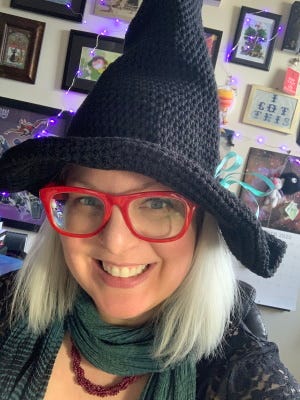
Halloween is just around the corner! Trick-or-treat may be canceled, but there’s always time for a little spook—spooky music that is! But first? If you’re looking for a fun, safe Halloween party, I’ll be reading tarot cards from The Halloween Tarot deck in costume from 5-7pm PST during the SFWA Halloween party. Shamble on over!
I’ve got a new game coming out, too. I’m one of the writers who worked on World of Darkness: Ghost Hunters on Kickstarter. The manuscript is finished and you can read previews when you back it; I wrote the Storyteller chapter which… You can tell… Because there’s a lot of bullet points. SO MANY BULLET POINTS!
Back to the tunes! To prep for today’s Music Monday, I put a spell on my keyboard. Just gotta hit... Wait. Why am I looking at TWO keyboards. And swirling rainbows with lava lamps? What the hell?
WEEE-OOOHHHHH WEEEE-OHHHHHHHH! FOOOOOOOM.
The year is 1972. Richard Nixon is President. This is a year of protest and war; the Black Panthers, Watergate, Vietnam, the Cold War, and the Space Race.
This is the year of polyester, bell bottoms, colored tights, and daring miniskirts. David Bowie, The Beatles, Stevie Wonder, Bob Marley, and Queen. The Godfather, Fist of Fury, Slaughterhouse Five, and The Last Tango in Paris.
The early ‘70s also marked the beginning of a witchcraft revival in Great Britain and in America. Dianic Wicca, founded by Zsuzsanna Budapest in 1971, operates as a “women-only” coven that emerges from Gardnerian Wicca (1954), Charles Leland’s Aradia (1899), and second-wave feminism (Women’s Liberation Movement).
Following the success of Bewitched (1964-1972) you’d think that pop culture would have embraced more feminist depictions of witches in the 1970s, and more media would be written, performed, and published by women. Right? Well, not exactly. Made-for-TV movies in this era reinforced witches as practitioners of the dark arts and, as the decade continued, helped foster a growing misogynistic backlash. Whether by accident or by design, the cultural zeitgeist ensured that witches should be defined as “evil” for years to come.
There are several songs about witches in the 1970s; most of them are written and performed by men (notably, Fleetwood Mac’s Stevie Nicks is an exception). Styx, Santana, The Eagles, Black Sabbath, and Jethro Tull are just a few of the 70s bands with witchy tunes in their repetoire—along with a short-lived group from Florida called White Witch who, before their shows, said their purpose was: “To bring good where there once was evil, to bring love where there once was hate, to bring wisdom where there once was ignorance; this is the power of White Witch.”
Today, I picked “Help Me Lord” for you, because it’s an odd story sung by White Witch about an elderly woman who is exhausted from fighting a demon. If you’re unfamiliar with the historical context, the existence of Christian white witches is historically accurate—loooooonnnnnnnggggg before the invention of psychedelic rock.
“Help Me Lord” was released on the band’s debut album White Witch. Unlike many hard rock/heavy metal bands that leaned into the occult for symbolism and rockin’ inspiration, White Witch is all about that good mojo—an unusual message from a short-lived band.
Just remember: DON’T HEX THE MOON!




